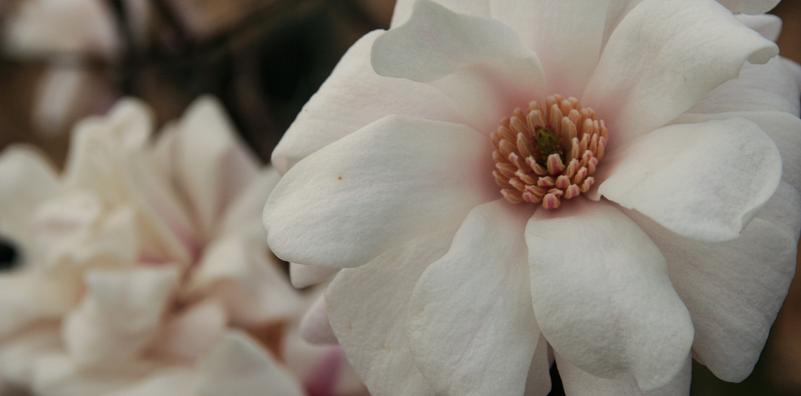Magnolia Madness!
The unraveling of magnolia flowers signifies the arrival of true spring, and this year we’ve been blessed with warm enough weather that ensures blooms won’t be destroyed by an unexpected frost. In both the landscape as well as our production houses, the magnolias are springing to life, tempting passersby with their delicate floral fragrance. Despite our meager human attraction to the large, varied, prehistoric flowers, magnolias have evolved specifically to seduce Coleopterans (beetles), Dipterans (flies), and Hymenopterans (bees, wasps, and ants). Some Central and South American magnolia species play host to scarab beetles, who not only pollinate the flowers, but also derive nutrients from the petals and utilize the large floral spaces as shelter for reproductive activities.
Several of our North American species, such as Magnolia grandiflora, Magnolia tripetala, Magnolia macrophylla, and Magnolia virginiana have evolved with primarily white flowers, while Magnolia acuminata is differentiated by its unique yellow flowers, differing from the standard pinks, reds, and purples of Asian species. Interestingly, our white native magnolias produce flowers imbued with specialized display patterns that are visible in ultraviolet light, even to the naked human eye in subtle darkness, thought to attract beetle pollinators that are known for deploying their “mess and spoil” technique of transporting pollen as they tromp around the central petals. These UV-sensitive display patterns, often purple to red in color, serve as guide points for roving beetles, while some of the more blue-colored patterns are known to attract bees who have been a historically controversial topic in the terms of magnolia pollination.
During the dawn of angiosperms (flowering plants), bees did not yet exist, meaning magnolia trees first evolved specifically to attract flightless beetles, and over time expanded their cross-pollination needs to include Hymenopterans. In modern times, it’s likely that you’ll find all three insect families traveling from magnolia flower to magnolia flower, resulting in the creation of interspecific hybrids and inspiring the production of interesting cultivars. Of these selections, several of them are known to bloom earlier than others: this week, ‘White Rose’, ‘Frank’s Masterpiece’, ‘Goldfinch’ and ‘Royal Purple’ magnolias have graced us with their floral display paired with their perfumy fragrance.
If you happen to be stopping by the nursery in the next couple of weeks, make sure to swing by House J5 to enjoy the show yourself! We are anticipating an influx of magnolia selections to our inventory throughout the growing season, so make sure to check our availability regularly for updates and grower’s information or click the “Get Notified” link for future crops and be the first to know when they’re available!
See all our Woody Ornamentals

Magnolia x loebneri 'White Rose'

